Influence of Al on Evolution of the Inclusions in Ti-Bearing Steel with Ca Treatment
Abstract
1. Introduction
2. Experimental Methods
3. Results and Discussion
3.1. Chemical Composition, Size Distribution, and Morphologies of Inclusions
3.2. Thermodynamic Analysis of Al–Ti–Ca–O System
4. Conclusions
Author Contributions
Funding
Conflicts of Interest
References
- Liu, H.; Wang, H.; Li, L.; Zheng, J.; Li, Y.; Zeng, X. Investigation of Ti inclusions in wire cord steel. Ironmak. Steelmak. 2011, 38, 53–58. [Google Scholar] [CrossRef]
- Liu, T.; Chen, L.; Bi, H.; Che, X. Effect of Mo on high-temperature fatigue behavior of 15CrNbTi ferritic stainless steel. Acta Metall. Sin. 2014, 27, 452–456. [Google Scholar] [CrossRef]
- Zhang, J.; Cao, Y.; Jiang, G.; Di, H. Effect of annealing temperature on the precipitation behavior and texture evolution in a warm rolled P-containing interstitial-free high strength steel. Acta Metall. Sin. 2014, 27, 395–400. [Google Scholar] [CrossRef]
- Lee, Y.D.; Park, S.H. Effects of titanium and niobium on the weldability of 11% Cr ferritic stainless steel. J. Korean Inst. Met. Mater. 1993, 31, 984–987. [Google Scholar]
- Kim, H.S.; Chang, C.-H.; Lee, H.-G. Evolution of inclusions and resultant microstructural change with Mg addition in Mn/Si/Ti deoxidized steels. Scr. Mater. 2005, 53, 1253–1258. [Google Scholar] [CrossRef]
- Wang, C.; Misra, R.; Shi, M.; Zhang, P.; Wang, Z.; Zhu, F.; Wang, G. Transformation behavior of a Ti–Zr deoxidized steel: Microstructure and toughness of simulated coarse grain heat affected zone. Mater. Sci. Eng. A 2014, 594, 218–228. [Google Scholar] [CrossRef]
- Nakai, K.; Yudate, A.; Kobayashi, S.; Hamada, M.; Komizo, Y. Effects of Ti-based oxide inclusions on formation of intragranular ferrite in steel. Tetsu-to-Hagané 2004, 90, 141–145. [Google Scholar] [CrossRef]
- Kiviö, M.; Holappa, L.; Iung, T. Addition of dispersoid titanium oxide inclusions in steel and their influence on grain refinement. Metall. Mater. Trans. B 2010, 41, 1194–1204. [Google Scholar] [CrossRef]
- Kiviö, M.; Holappa, L. Addition of titanium oxide inclusions into liquid steel to control nonmetallic inclusions. Metall. Mater. Trans. B 2012, 43, 233–240. [Google Scholar] [CrossRef]
- Wang, C.; Verma, N.; Kwon, Y.; Tiekink, W.; Kikuchi, N.; Sridhar, S. A study on the transient inclusion evolution during reoxidation of a Fe-Al-Ti-O melt. ISIJ Int. 2011, 51, 375–381. [Google Scholar] [CrossRef]
- Wang, C.; Nuhfer, N.T.; Sridhar, S. Transient behavior of inclusion chemistry, shape, and structure in Fe-Al-Ti-O melts: Effect of titanium/aluminum ratio. Metall. Mater. Trans. B 2009, 40, 1022–1034. [Google Scholar] [CrossRef]
- Wang, C.; Nuhfer, N.T.; Sridhar, S. Transient behavior of inclusion chemistry, shape, and structure in Fe-Al-Ti-O melts: Effect of titanium source and laboratory deoxidation simulation. Metall. Mater. Trans. B 2009, 40, 1005–1021. [Google Scholar] [CrossRef]
- Zhang, T.; Liu, C.; Jiang, M. Effect of Mg on behavior and particle size of inclusions in Al-Ti deoxidized molten steel. Metall. Mater. Trans. B 2016, 47, 2253–2262. [Google Scholar] [CrossRef]
- Wang, D.; Jiang, M.; Matsuura, H.; Tsukihashi, F. Dynamic evolution of inclusions in Ti-bearing Al-deoxidized molten irons at 1873 K. Steel Res. Int. 2014, 85, 16–25. [Google Scholar] [CrossRef]
- Basu, S.; Choudhary, S.K.; Narendra, U. Nozzle Clogging Behaviour of Ti-bearing Al-killed Ultra Low Carbon Steel. ISIJ Int. 2004, 44, 1653–1660. [Google Scholar] [CrossRef]
- Kawashima, Y.; Nagata, Y.; Shinme, K. Influence of Ti concentration on nozzle clogging on Al-Ti deoxidation: behavior of inclusion on Al-Ti deoxidation-2. CAMP-ISIJ 1991, 4, 1237–1242. [Google Scholar]
- Jung, I.H.; Eriksson, G.; Wu, P.; Pelton, A. Thermodynamic modeling of the Al2O3-Ti2O3-TiO2 system and its applications to the FeAl-Ti-O inclusion diagram. ISIJ Int. 2009, 49, 1290–1297. [Google Scholar] [CrossRef]
- Ruby-Meyer, F.; Lehmann, J.; Gaye, H. Thermodynamic analysis of inclusions in Ti-deoxidised steels. Scand. J. Metall. 2000, 29, 206–212. [Google Scholar] [CrossRef]
- Park, D.-C.; Jung, I.-H.; Rhee, P.C.H.; Lee, H.-G. Reoxidation of Al-Ti containing steels by CaO-Al2O3-MgO-SiO2 slag. ISIJ Int. 2004, 44, 1669–1678. [Google Scholar] [CrossRef]
- Doo, W.-C.; Kim, D.-Y.; Kang, S.-C.; Yi, K.-W. Measurement of the 2-dimensional fractal dimensions of alumina clusters formed in an ultra low carbon steel melt during RH process. ISIJ Int. 2007, 13, 249–258. [Google Scholar] [CrossRef]
- Zinngrebe, E.; Van Hoek, C.; Visser, H.; Westendorp, A.; Jung, I.-H. Inclusion population evolution in Ti-alloyed Al-killed steel during secondary steelmaking process. ISIJ Int. 2012, 52, 52–61. [Google Scholar] [CrossRef]
- Van Ende, M.-A.; Guo, M.; Dekkers, R.; Burty, M.; Van Dyck, J.; Jones, P.; Blanpain, B.; Wollants, P. Formation and evolution of Al-Ti oxide inclusions during secondary steel refining. ISIJ Int. 2009, 49, 1133–1140. [Google Scholar] [CrossRef]
- Matsuura, H.; Wang, C.; Wen, G.; Sridhar, S. The transient stages of inclusion evolution during Al and/or Ti additions to molten iron. ISIJ Int. 2007, 47, 1265–1274. [Google Scholar] [CrossRef]
- Seo, M.-D.; Cho, J.-W.; Kim, K.-C.; Kim, S.-H. Evolution of nonmetallic inclusions in ultra low carbon steel after aluminum deoxidization. ISIJ Int. 2014, 54, 475–481. [Google Scholar] [CrossRef]
- Wu, Z.; Zheng, W.; Li, G.; Matsuura, H.; Tsukihashi, F. Effect of inclusions’ behavior on the microstructure in Al-Ti deoxidized and magnesium-treated steel with different aluminum contents. Metall. Mater. Trans. B 2015, 46, 1226–1241. [Google Scholar] [CrossRef]
- Wang, C.; Nuhfer, N.T.; Sridhar, S. Transient behavior of inclusion chemistry, shape, and structure in Fe-Al-Ti-O melts: Effect of gradual increase in Ti. Metall. Mater. Trans. B 2010, 41, 1084–1094. [Google Scholar] [CrossRef]
- Itoh, H.; Hino, M. Assessment of Al deoxidation equilibrium in liquid iron. Tetsu-to-Hagané 1997, 83, 773–778. [Google Scholar] [CrossRef]
- Zhang, L.; Thomas, B.G. State of the art in evaluation and control of steel cleanliness. ISIJ Int. 2003, 43, 271–291. [Google Scholar] [CrossRef]
- Park, J.H.; Todoroki, H. Control of MgO Al2O3 Spinel Inclusions in stainless steels. ISIJ Int. 2010, 50, 1333–1346. [Google Scholar] [CrossRef]
- Jung, I.H. Overview of the applications of thermodynamic databases to steelmaking processes. Calphad 2010, 34, 332–362. [Google Scholar] [CrossRef]
- Taguchi, K.; Ono-nakazato, H.; Usui, T.; Marukawa, K.; Katogi, K.; Kpsaka, H. Complex deoxidation equilibria of molten iron by aluminum and calcium. ISIJ Int. 2005, 45, 1572–1576. [Google Scholar] [CrossRef]
- Kurayasu, H.; Takayama, T.; Hinotani, S.; Shirota, Y. Phase analysis of Ca-containing inclusions in Ca-treated steels. Tetsu-to-Hagané 1996, 82, 1017–1022. [Google Scholar] [CrossRef]
- Herrera, M.; Castro, F.; Castro, M.; Méndez, M.; Solís, H.; Castellá, A.; Barbaro, M. Modification of Al2O3 inclusions in medium carbon aluminium killed steels by AlCaFe additions. Ironmak. Steelmak. 2006, 33, 45–51. [Google Scholar] [CrossRef]
- Blah, C.; Espérance, G.L.; LeHuy, H.; Forget, C. Development of an integrated method for fully characterizing multiphase inclusions and its application to calcium-treated steels. Mater. Charact. 1997, 38, 25–37. [Google Scholar]
- Holappa, L.; Hämäläinen, M.; Liukkonen, M.; Lind, M. Thermodynamic examination of inclusion modification and precipitation from calcium treatment to solidified steel. Ironmak. Steelmak. 2003, 30, 111–115. [Google Scholar] [CrossRef]
- Lind, M.; Holappa, L. Transformation of alumina inclusions by calcium treatment. Metall. Mater. Tran. B 2010, 41, 359–366. [Google Scholar] [CrossRef]
- Zhang, T.; Min, Y.; Liu, C.; Jiang, M. Effect of Mg addition on the evolution of inclusions in Al–Ca deoxidized melts. ISIJ Int. 2015, 55, 1541–1548. [Google Scholar] [CrossRef]
- Seo, C.-W.; Kim, S.-H.; Jo, S.-K.; Suk, M.-O.; Byun, S.-M. Modification and minimization of spinel (Al2O3·xMgO) inclusions formed in Ti-added steel melts. Metall. Mater. Trans. B 2010, 41, 790–797. [Google Scholar] [CrossRef]
- Zheng, W.; Wu, Z.; Li, G.; Zhang, Z.; Zhu, C. Effect of Al content on the characteristics of inclusions in Al–Ti complex deoxidized steel with calcium treatment. ISIJ Int. 2014, 54, 1355–1364. [Google Scholar] [CrossRef]
- Mizoguchi, T.; Ueshima, Y. Determination of the Ti2O3-CaO-Al2O3 phase diagram at steelmaking Temperature. Tetsu-to-Hagané 2005, 91, 376–382. [Google Scholar] [CrossRef]
- Kim, K.-H.; Do, K.-H.; Choi, W.-J.; Lee, S.-B.; Kim, D.-S.; Pak, J.-J. Inclusion modification by Al deoxidation and Ca treatment in Ti containing 18%Cr stainless steel melts. Korean J. Met. Mater. 2013, 51, 113–118. [Google Scholar]
- Zheng, H.; Chen, W. Formation of CaO·TiO2-MgO·Al2O3 dual phase inclusion in Ti stabilized stainless steel. J. Univ. Sci. Technol. B 2006, 13, 16–20. [Google Scholar] [CrossRef]
- Pak, J.-J.; Jo, J.-O.; Kim, S.-I.; Kim, W.-Y.; Chung, T.-I.; Seo, S.-M.; Park, J.-H.; Kim, D.-S. Thermodynamics of titanium and oxygen dissolved in liquid iron equilibrated with titanium oxides. ISIJ Int. 2007, 47, 16–24. [Google Scholar] [CrossRef]
- Cha, W.-Y.; Miki, T.; Sasaki, Y.; Hino, M. Identification of titanium oxide phases equilibrated with liquid Fe-Ti alloy based on EBSD analysis. ISIJ Int. 2006, 46, 987–995. [Google Scholar] [CrossRef]
- Cha, W.-Y.; Nagasaka, T.; Miki, T.; Sasaki, Y.; Hino, M. Equilibrium between titanium and oxygen in liquid Fe-Ti alloy coexisted with titanium oxides at 1873 K. ISIJ Int. 2006, 46, 996–1005. [Google Scholar] [CrossRef]
- Seok, S.-H.; Miki, T.; Hino, M. Equilibrium between Ti and O in Molten Fe-Ni, Fe-Cr and Fe-Cr-Ni Alloys Equilibrated with ‘Ti3O5’ Solid Solution. ISIJ Int. 2011, 51, 566–572. [Google Scholar] [CrossRef]
- Itoh, H.; Hino, M.; Ban-ya, S. Deoxidation equilibrium of calcium in liquid iron. Tetsu-to-Hagané 1997, 83, 695–700. [Google Scholar] [CrossRef]
- Nagata, K.; Tanabe, J.; Goto, K.S. Standard free energies of formation of CaO-Al2O3 intermediate compounds by means of EMF measurement of galvanic cells. Tetsu-to-Hagané 1989, 75, 2013–2030. [Google Scholar] [CrossRef]
- Yang, W.; Zhang, L.; Wang, X.; Ren, Y.; Liu, X.; Shan, Q. Characteristics of inclusions in low carbon Al-killed steel during ladle furnace refining and calcium treatment. ISIJ Int. 2013, 53, 1401–1410. [Google Scholar] [CrossRef]
- Cha, W.-Y.; Miki, T.; Sasaki, Y.; Hino, M. Temperature dependence of Ti deoxidation equilibria of liquid iron in coexistence with ‘Ti3O5’ and Ti2O3. ISIJ Int. 2008, 48, 729–738. [Google Scholar] [CrossRef]
- Hong, T.; Debroy, T. Time-temperature-transformation diagrams for the growth and dissolution of inclusions in liquid steels. Scr. Mater. 2001, 44, 847–852. [Google Scholar] [CrossRef]
- The Japan Society for the Promotion of Science. Steelmaking Data Sourcebook; Gordon and Breach Science Publishers: New York, NY, USA, 1988. [Google Scholar]
- Chen, J. Handbook of Data on Steelmaking, 2nd ed.; Metallurgical Industry Press: Beijing, China, 2010. [Google Scholar]
- Kishi, M.; Inoue, R.; Suito, H. Thermodynamics of oxygen and nitrogen in liquid Fe-20 mass% Cr alloy equilibrated with titania based slags. ISIJ Int. 1994, 34, 859–867. [Google Scholar] [CrossRef]
- Ohta, M.; Morita, K. Thermodynamics of the MnO-Al2O3-TiO2 system. ISIJ Int. 1999, 39, 1231–1238. [Google Scholar] [CrossRef]
- Morioka, Y.; Morita, K.; Tsukihashi, F.; Sano, N. Equilibria between molten steels and inclusions during deoxidation by titanium-manganese alloy. Tetsu-to-Hagané 1995, 81, 40–45. [Google Scholar] [CrossRef]
- Karasev, A.; Suito, H. Analysis of size distributions of primary oxide inclusions in Fe-10 mass Pct Ni-M (M = Si, Ti, Al, Zr, and Ce) alloy. Metall. Mater. Trans. B 1999, 30, 149–157. [Google Scholar] [CrossRef]
- Ohta, M.; Morita, K. Thermodynamics of the Al2O3-SiO2-TiOX oxide system at 1873 K. ISIJ Int. 2002, 42, 474–481. [Google Scholar] [CrossRef]
- Ma, Z.; Janke, D. Characteristics of oxide precipitation and growth during solidification of deoxidized steel. ISIJ Int. 1998, 38, 46–52. [Google Scholar] [CrossRef]
- Cho, S.W.; Suito, H. Assessment of Aluminum-Oxygen equilibrium in liquid iron and activities in CaO-Al2O3-SiO2 slags. ISIJ Int. 1994, 34, 177–185. [Google Scholar] [CrossRef]
- Taguchi, K.; Ono-nakazato, H.; Nakai, D.; Usui, T.; Marukawa, K. Deoxidation and desulfurization equilibria of liquid iron by calcium. ISIJ Int. 2003, 43, 1705–1709. [Google Scholar] [CrossRef]
- Itoh, H.; Hino, M. Thermodynamics on the formation of spinel nonmetallic inclusion in liquid steel. Metall. Mater. Trans. B 1997, 28, 953–956. [Google Scholar] [CrossRef]
- Jo, S.K.; Song, B. Thermodynamics on the formation of spinel (MgO·Al2O3) inclusion in liquid iron containing Chromium. Metall. Mater. Trans. B 2002, 33, 703–709. [Google Scholar] [CrossRef]
- Ishii, F.; Ban-ya, S. Thermodynamics of the deoxidation equilibrium of aluminum in liquid nickel and Nickel-Iron alloys. ISIJ Int. 1996, 36, 25–31. [Google Scholar] [CrossRef]
- Higuchi, Y.; Numata, M. Effect of method of Ca treatment on composition and shape of non-metallic inclusions. Tetsu-to-Hagané 1996, 82, 671–676. [Google Scholar] [CrossRef]
- Ohta, H.; Suito, H. Activities in CaO-MgO-Al2O3 slags and deoxidation equilibria of Al, Mg, and Ca. ISIJ Int. 1996, 36, 983–990. [Google Scholar] [CrossRef]
- Itoh, H.; Hino, M. Thermodynamics on the formation of nonmetallic inclusion of spinel (MgO·Al2O3) in liquid steel. Tetsu-to-Hagané 1998, 84, 85–90. [Google Scholar] [CrossRef]
- Satoh, N.; Taniguchi, T. Prediction of nonmetallic inclusion formation in Fe-40mass% Ni-5mass% Cr alloy production process. Tetsu-to-Hagané 2009, 95, 827–836. [Google Scholar] [CrossRef]
- Cho, S.W.; Suito, H. Assessment of calcium-oxygen equilibrium in liquid iron. ISIJ Int. 1994, 34, 265–269. [Google Scholar] [CrossRef]
- Zhang, T.; Wang, D.; Jiang, M. Effect of Magnesium on the Evolution of Oxide and Sulphide in Liquid Iron at 1873K. J. Iron Steel Res. Int. 2014, 21, 1073–1080. [Google Scholar] [CrossRef]
- Zhang, L.; Ren, Y.; Duan, H.; Yang, W.; Sun, L. Stability Diagram of Mg-Al-O System Inclusions in Molten Steel Effect of Magnesium on the Evolution of Oxide and Sulphide in Liquid Iron at 1873K. Metall. Mater. Trans. B 2015, 46, 1809–1825. [Google Scholar] [CrossRef]


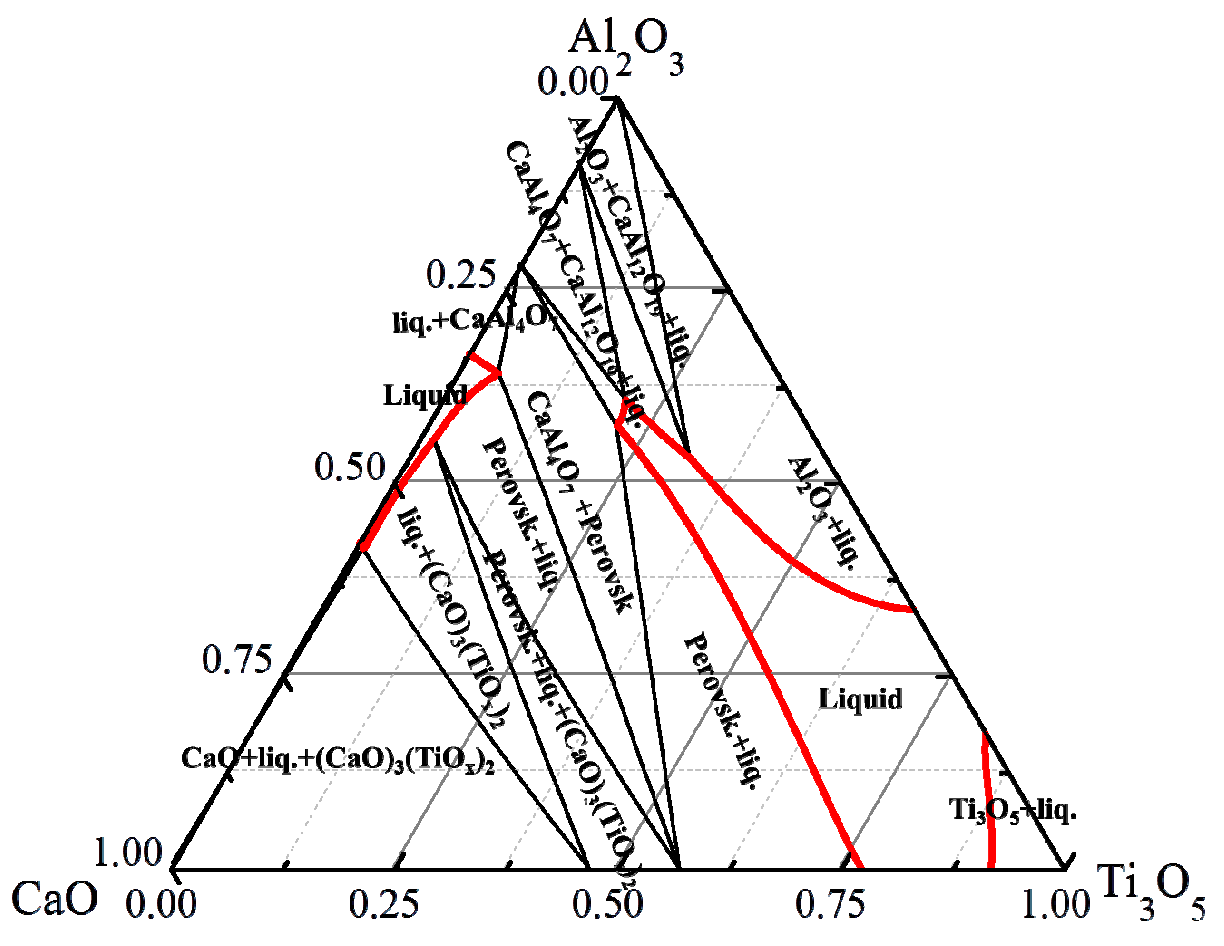
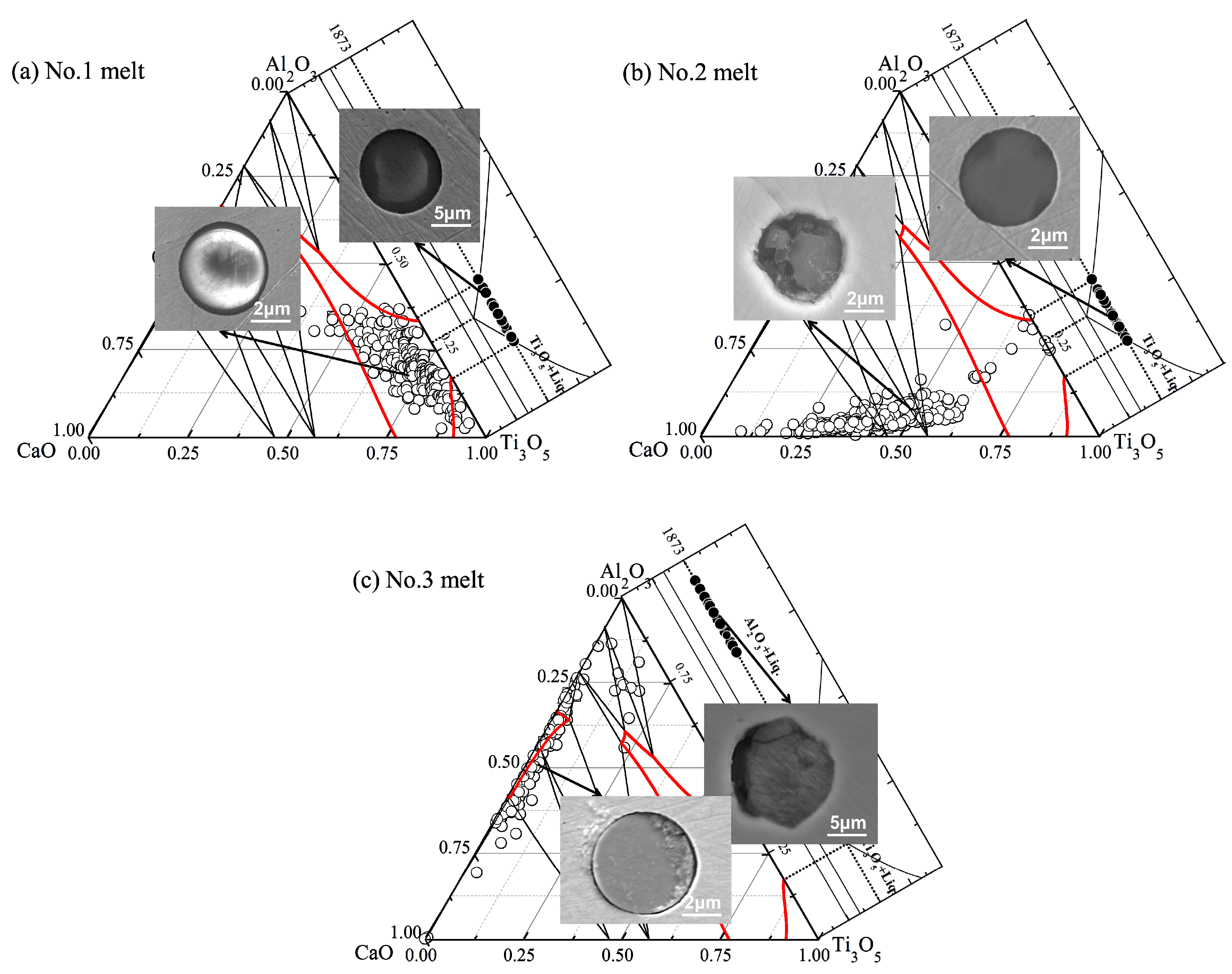

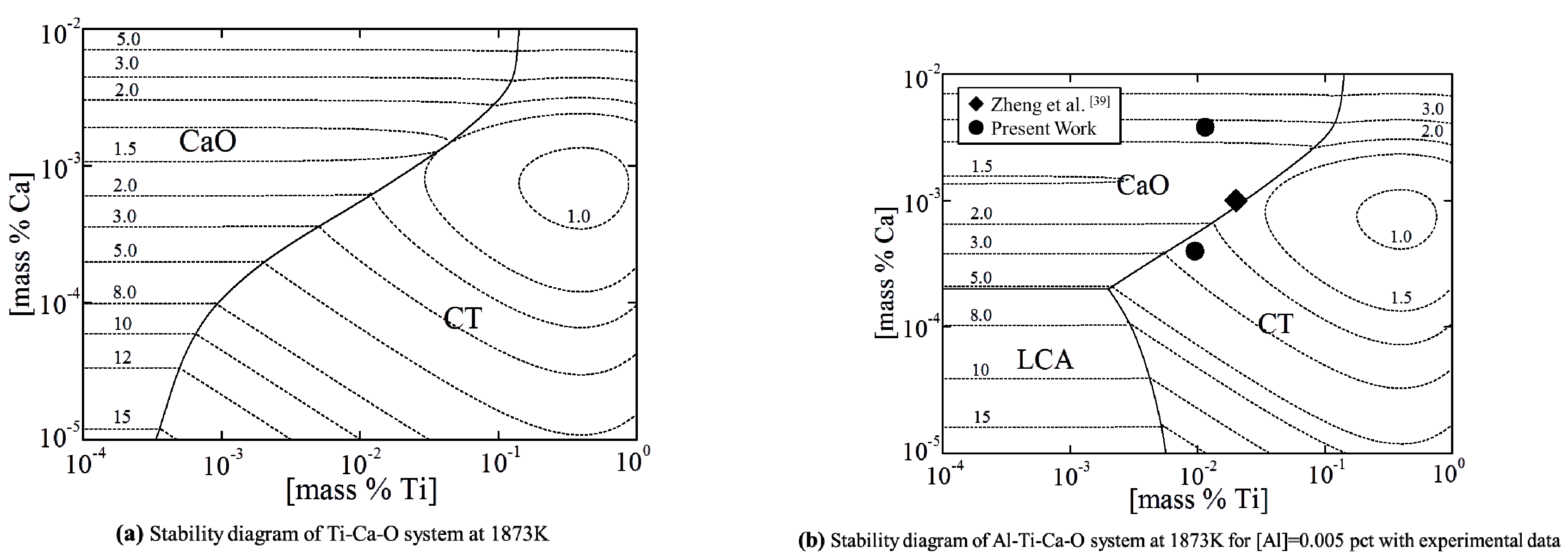
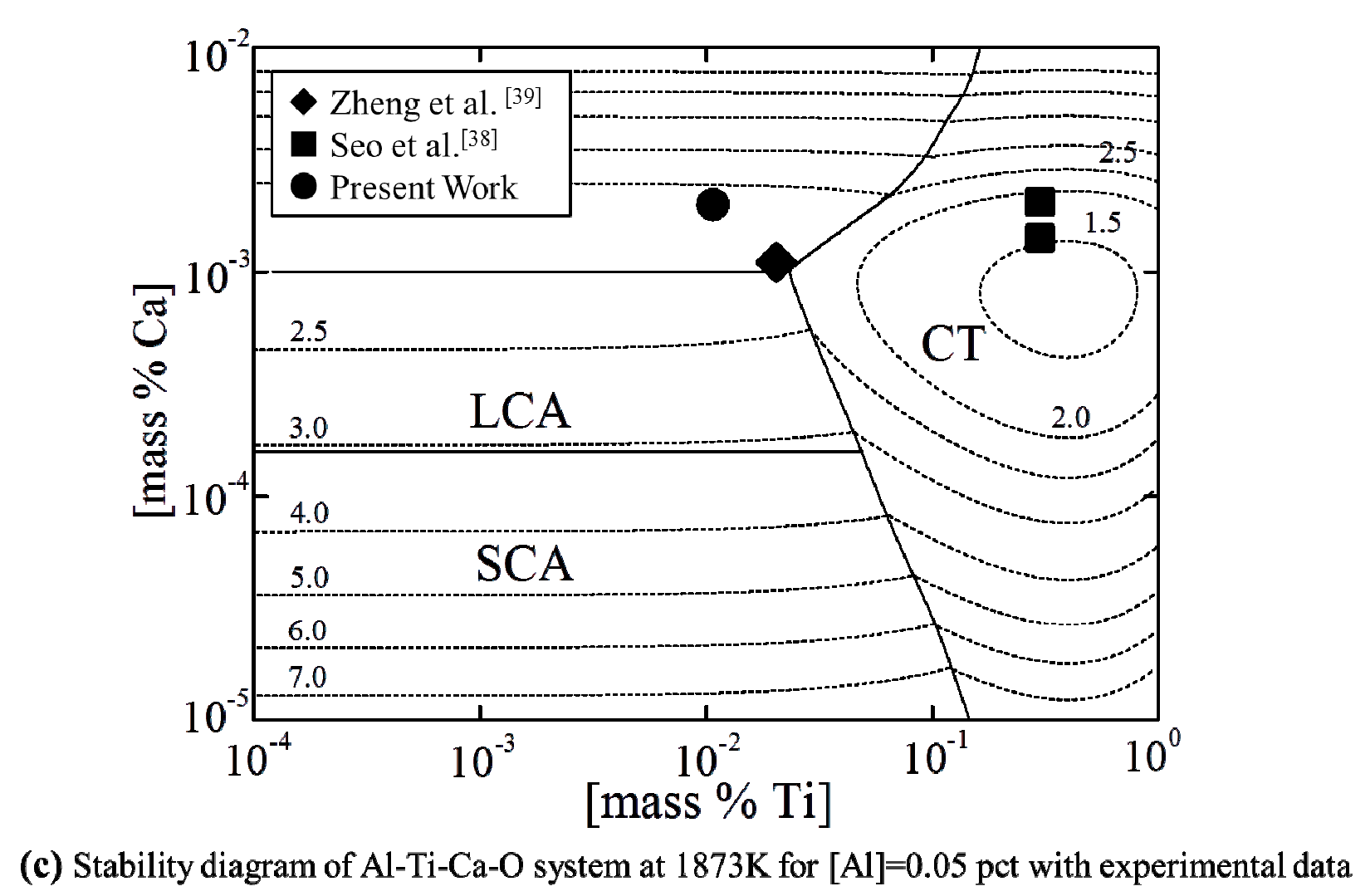

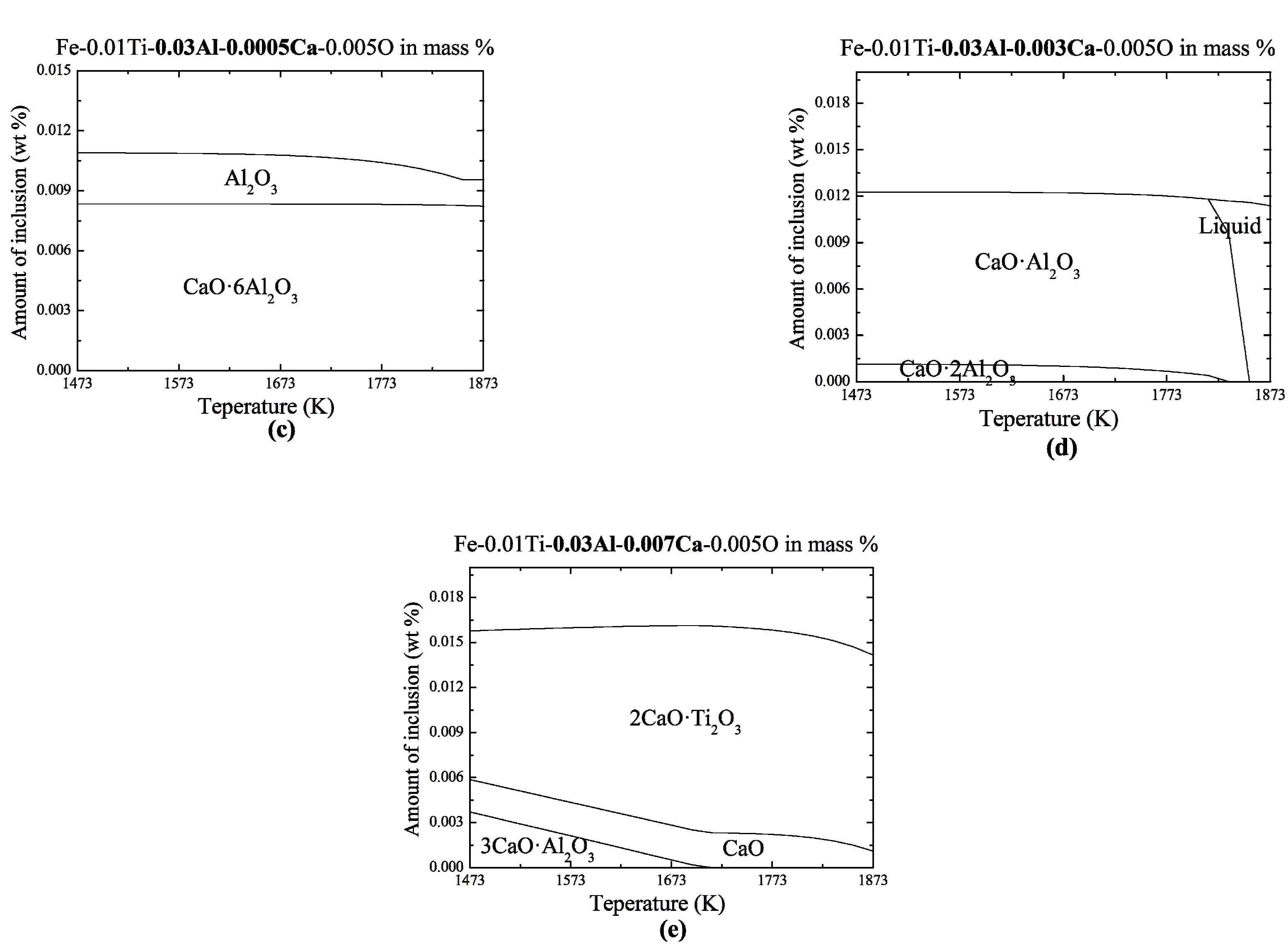
| Type | Fe | C | Ti | Mn | Si | Ca | Al | P | S | Others |
|---|---|---|---|---|---|---|---|---|---|---|
| Ca–Fe alloy | 69.82 | - | - | - | - | 30.10 | - | - | - | 0.08 |
| Ti–Fe alloy | 26.513 | 0.130 | 69.594 | 0.241 | 0.030 | - | 3.192 | 0.025 | 0.011 | 0.284 |
| Al wire | - | - | - | - | - | - | 99.99 | - | - | 0.01 |
| Pure iron | 99.944 | 0.002 | - | 0.03 | 0.01 | - | 0.001 | 0.007 | 0.007 | 0.043 |
| No. | [Al] | [Ca] | [Ti] | a[O] | T.[O] |
|---|---|---|---|---|---|
| 1-A | 0.0042 | - | 0.0105 | 0.0005 | 0.0053 |
| 1-B | 0.0036 | 0.0005 | 0.0094 | - | 0.0049 |
| 2-A | 0.0053 | - | 0.0118 | 0.0006 | 0.0045 |
| 2-B | 0.0051 | 0.0038 | 0.0115 | - | 0.0038 |
| 3-A | 0.0430 | - | 0.0112 | 0.0002 | 0.0038 |
| 3-B | 0.0413 | 0.0025 | 0.0106 | - | 0.0032 |
| No. | Reactions | ΔGθ = A + B × T /J·mol−1 | References | |
|---|---|---|---|---|
| A | B | |||
| 1 | Al2O3 = 2[Al] + 3[O] | 867,500 | −222.5 | [27] |
| 2 | CaO = [Ca] + [O] | 138,227 | 63.0 | [47] |
| 3 | Al2TiO5 = [Ti] + 2[Al] + 5[O] | 1,435,000 | −40.5 | [23] |
| 4 | CaO·6Al2O3 = CaO(s) + 6Al2O3(s) | 16,380 | 37.58 | [48] |
| 5 | CaO·2Al2O3 = CaO(s) + 2Al2O3(s) | 15,650 | 25.82 | [48] |
| 6 | CaO·Al2O3 = CaO(s) + Al2O3(s) | 17,910 | 17.38 | [48] |
| 7 | 12CaO·7Al2O3 = 12CaO(s) + 7Al2O3(s) | −618,000 | 612.1 | [49] |
| 8 | Ti2O3 =2[Ti] + 3[O] | 822,000 | −247.7 | [50] |
| 9 | Ti3O5 =3[Ti] + 5[O] | 1,307,000 | −381.8 | [50] |
| 10 | TiO2 = [Ti] + 2[O] | −675,600 | 234 | [51] |
| 11 | 3CaO·Ti2O3 = 3CaO(s) + Ti2O3(s) | 192,745 (1873K) | [52] | |
| 12 | 3CaO·2TiO2 = 3CaO(s) + 2TiO2(s) | 148,365 | 24.14 | [52] |
| 13 | CaO·TiO2 = CaO(s) + TiO2(s) | 74,392 | 10.13 | [53] |
| i | j | k | i | j | k | ||||||
|---|---|---|---|---|---|---|---|---|---|---|---|
| O | Al | Ca | −3.9 | −0.01 | 0 | Al | Al | O | 0.043 | −0.001 | −0.028 |
| Ti | - | Ca | O | −0.047 | 0 | 0 | |||||
| O | 47.45 | Ti | - | 0.004 | - | - | |||||
| Ca | Al | −310 | −17,984 | 0 | O | Al | −1.98 | 39.82 | −0.028 | ||
| O | 519,903 | Ca | 0 | ||||||||
| Ti | O | −0.34 | 0.031 | 0.026 | Ca | Al | - | −0.072 | 0.0007 | - | |
| O | Al | −0.20 | 0 | 47.45 | Ca | O | −0.002 | - | −90,227 | ||
| Ca | 520,000 | Ti | - | −0.13 | - | - | |||||
| Ti | Al | - | 0.0037 | - | - | O | Ca | −580 | 650,129 | −90,056 | |
| Ti | O | 0.042 | −0.001 | 0.20 | - | ||||||
| O | Ti | −3.4 | −0.0355 | 0.20 | |||||||
© 2019 by the authors. Licensee MDPI, Basel, Switzerland. This article is an open access article distributed under the terms and conditions of the Creative Commons Attribution (CC BY) license (http://creativecommons.org/licenses/by/4.0/).
Share and Cite
Li, Y.; Zhang, T.; Duan, H. Influence of Al on Evolution of the Inclusions in Ti-Bearing Steel with Ca Treatment. Metals 2019, 9, 104. https://doi.org/10.3390/met9010104
Li Y, Zhang T, Duan H. Influence of Al on Evolution of the Inclusions in Ti-Bearing Steel with Ca Treatment. Metals. 2019; 9(1):104. https://doi.org/10.3390/met9010104
Chicago/Turabian StyleLi, Yandong, Tongsheng Zhang, and Huamei Duan. 2019. "Influence of Al on Evolution of the Inclusions in Ti-Bearing Steel with Ca Treatment" Metals 9, no. 1: 104. https://doi.org/10.3390/met9010104
APA StyleLi, Y., Zhang, T., & Duan, H. (2019). Influence of Al on Evolution of the Inclusions in Ti-Bearing Steel with Ca Treatment. Metals, 9(1), 104. https://doi.org/10.3390/met9010104






